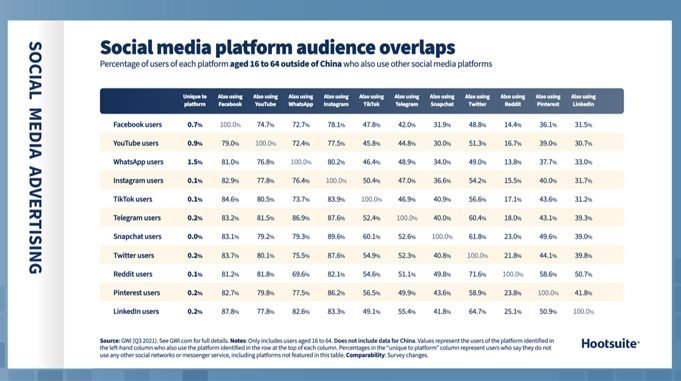What’s the Best B2B Social Media Marketing Strategy for Your Brand?

Finding the right digital community to bolster your business used to be a simple task. The state of social media today has created many community choices. Each social media platform can feel like a chessboard, with content acting like chess pieces — each post or video creating an environment of moves and countermoves in managing a given lead strategy.
Yet most marketers may not feel like “chessmasters” of their industry. Marketers face a dizzying array of social media “chessboards” they can use to connect to customers and generate leads.
Where Are People Spending Social Media Time?
Hootsuite’s latest study, The Global State of Digital for 2022, gives a glimpse at potential answers. The research captured where people are currently spending their time on social media. The results reflect where B2B marketers should be to find potential customers.
The short answer — more than one place — is likely an obvious one. The study also showed how having multiple presences influences opportunities for discovering how to grow a social media presence.

People Are Moving Around on Social Media
Content is a main driver of top-of-funnel sales activities, and social media has become the main delivery channel for it. Social media plays a role in how customers research brands, discover interesting media content, and then decide to engage that brand for their needs. The COVID-19 pandemic has enticed customers to spend more time on social media, leading businesses to direct content teams to alter their reach to customers in unprecedented ways.
In its study, Hootsuite discovered the degree of audience overlap of someone appearing on one platform against another. It’s no secret that people who use social media sites are often on two or more platforms, as people are naturally social. Hootsuite notes the average person uses 7.5 platforms, so there are an array of combinations.
For example, 84% of TikTok users are also on Facebook, 45% of YouTube users are also on TikTok. Among LinkedIn users, 49.1% also use TikTok, while 50.9% also use Pinterest. These numbers imply a consistent opportunity to provide omnichannel strategies for connecting where an audience spends their time.
Marketers Can’t Be Influenced by Every Number
An intriguing aspect? Not many people remain on one platform. Hootsuite found very few social media users between the ages of 16 and 64 who use only one platform. Every platform, save for Reddit, had a percentage of single platform users under 1%.
Back in 2020, Sagefrog researched social media platform preferences among B2B firms. It found respondents skewing their social media presence to one platform at the expense of incorporating other social media platforms that can enhance their marketing strategy.
Hootsuite cautions that marketers should not consider the broad social media usage as a sign to combine budgets for platforms or remove a presence on one or more platforms.
Further, a look at the data shows that reciprocity of usage is not occurring. Take the TikTok-Facebook example: while 84% of TikTok users are also on Facebook, only 48% of Facebook users are also on TikTok. The uneven reciprocity may reflect the niche nature of social media platforms. While TikTok has seen increased adoption among a wider audience, TikTok is still filled with a niche audience, much like Twitter.
This differs from Facebook, which, despite recent woes on user adoption, retains a relatively broad audience. That difference may be a factor in the asymmetric movement between platforms.
Marketers Still in Love With Social
No matter the kind of audience overlap occurring among social media, marketers are clearly spending on advertising on social media platforms to build brand exposure and share messaging. One-third of global ad spend — $154 billion — is attributed to social media advertising. That amount is $21 billion more what marketers spent in 2021.
According to Sagefrog, social media is the second biggest source of B2B leads after business referrals. Thus the established social media platforms — LinkedIn, Facebook and Twitter — were the top choices respondents use for marketing. Newer social media platforms such as TikTok and platforms with strong niche audiences, like Pinterest, did not even appear in the results.
Build a Strong Omnichannel Presence
The clearest takeaway from this data is to experiment with omnichannel strategies. That experimentation must happen now.
B2B marketers should re-imagine where they can experiment with social media engagement to develop stronger customer leads. Take advantage of the different expectations people have from the content shared on these platforms. Social media users are in different mindsets on each platform. Some may be more playful on TikTok, while presenting a more serious tone on LinkedIn. Playful references to ideas and concept would be best on TikTok, even if there is a cross sharing from some LinkedIn user.
Developing a omnichannel strategy among social media platforms can improve the odds to connect to a specific audience. For example, Discord is widely used among developers and gamers. This trend may be useful for developing connections to developer talent for recruitment or for seeking a prominent tech influencer to develop a partnership.
Audit Mentions, Spot-Examine Leads
When you manage the channels with a social media dashboard like Tweetdeck or Hootsuite, audit the mentions and direct messages that become leads. The analysis will not be precise — it’s a spot examination of how leads are occurring on a given channel.
Yet you gain indicators of the general frequency of platform-related leads. You can then compare against your investment, be it time or budget spend. Attributing dollar value to a specific piece remains a complex task, but the analysis of events per week and per month will be a starting point for discussions on ROI.
Discuss planning social media advertising to support the content. Marketers clearly are spending more on social media marketing ads. A sprawling array of activity like the audience overlap demonstrate that marketers should be spending their time adjusting a digital ad budget between the social media platforms. Such adjustments can guide initial ROI estimates from advertising budgets.
Building a social media presence is an absolute need, yet the sizable challenge for B2B firms is understanding how to leverage an omnichannel presence that works for branding. The effort will lead to a better quality of connections to people who matter the most. Checkmate!
___
by Pierre DeBois
source: CMSWire.com

